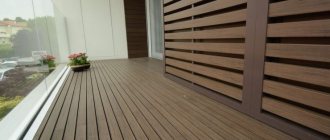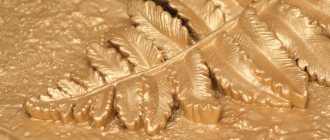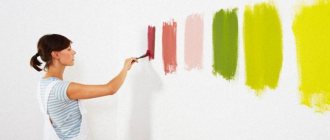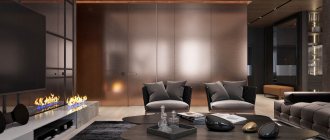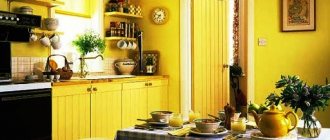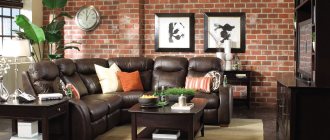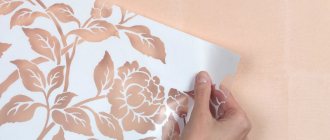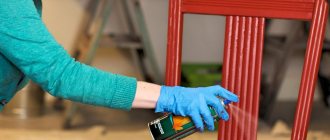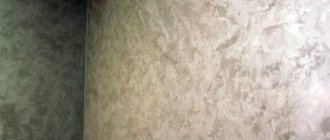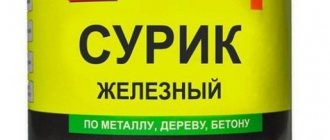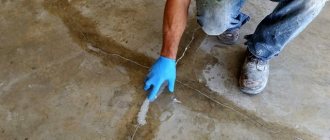kitchen furniture and sliding MDF screens in bathrooms. The following formulations can most often be found on sale:
Products from a Finnish manufacturer.
| Name | Options | price, rub. |
| Teknos Aquacoat paint | Aquacoat can be applied to MDF, solid wood and plywood with a moisture content not exceeding 20%. The composition can be used:
The paint dries quickly (2 hours between coats at a temperature of +23C) and has a high covering ability. Weather resistant. The manufacturer recommends application only using a sprayer. | 1l -800, 4.5l - 3200 |
Acrylic enamel from Belinka
| Name | Options | price, rub. |
| Belinka AQUA EMAIL | The composition is endowed with good hiding power, and upon application creates a glossy film. The manufacturer allows the composition to be applied over old paints and varnishes. Be sure to use an insulating primer. Among the features of this composition are:
This composition can be recommended for products located in direct visibility of sunlight. If you doubted whether it is possible to paint MDF wall panels that have faded in the sun, then applying Belinka AQUA EMAIL in 2-3 layers will make them resistant to ultraviolet exposure. | 590 for 0.75l; 1720 for 2.5l |
Acrylic enamel Garden Aqua from Finncolor (aka Tikkurila).
| Name | Options | price, rub. |
| Finncolor GARDEN AQUA | Universal semi-matte enamel. Area of application: for interior work, wood, plywood and MDF. It is allowed to use painted products in rooms with high humidity. The coatings are durable, the enamel has good elasticity. Application method: roller, spray. | 0.9l-560; 2.7l - 1600 |
Products from Ukrainian manufacturer.
| Name | Options | price, rub. |
| Paint FEIDAL Glanz Latex | Latex paint for covering MDF facades creates a non-erasing coating that is resistant to washing and weather conditions. Use only after surface treatment with FEIDAL Acryl-Tiefgrund. Application methods:
Drying time – 2 hours. The next layer is applied no earlier than 12 hours after the previous one. | 5l - 4300 |
Russian manufacturers also produce acrylic compositions at an affordable price.
| Name | Options | price, rub. |
| Tex Profi | Specialized acrylic based paint. Intended for:
Protects against mold, rot, fungi. Forms an elastic, weather-resistant, dirt-repellent coating. The manufacturer does not recommend using it for painting logs. Touch dry time is 24 hours. Resistant to washing, but not earlier than 14 days after painting the surfaces. | 0.9l - 320 |
Some of the presented compositions can also be used as an insulating primer. For such purposes, the manufacturer recommends diluting them with water in a ratio of 70% paint and 30% drinking water.
Before you paint a white MDF door to look like wood, be sure to:
- first apply a base layer of light paint, after which you can apply darker colors;
- Using a special rubber brush, without waiting for the second layer to dry, treat the surface to obtain the wood structure.
Decorix in aerosol packaging.
| Name | Features of application | price, rub. |
| Decorix | It is a glossy enamel. Endowed with the following advantages:
Packaging 400ml. | 140 |
Another representative of aerosol paints.
| Name | Features of application | price, rub. |
| Hobby Lack | The composition has good hiding power. Reliably protects treated surfaces from mechanical and atmospheric influences. Hobby Lack is the general name of an entire line. Produced in various modifications:
Recommended by the manufacturer for painting metal, wood and ceramic surfaces. Ideal for all types of plastics and glass. Capacity 0.4 l. | 180 |
Acrylic enamel in the process of application.
| KUDO ARTE | High-quality, quick-drying alkyd enamel is applied only to pre-primed wood surfaces. It has good hiding power, excellent adhesion, high gloss, and is resistant to impacts, bends and other mechanical influences. Reliable protection from precipitation, long service life. Packaging 0.4 l. | 150 |
Universal composition from KUDO.
Important: before painting MDF with alkyd spray, the surface should be treated with primer.
Alkyd and alkyd-urethane enamels
Another fairly large group of coloring compounds that allows you to paint MDF surfaces. If you don’t know how to repaint MDF furniture with your own hands, then for independent use I can recommend the products of the following manufacturers:
Representation of alkyd compositions from the Finnish manufacturer Tikkurila.
| Name | Technical features | price, rub. |
| Tikkurila TEHO | Alkyd-oil paint is recommended by the manufacturer for painting both new and already painted wooden facades, as well as all kinds of sawn and planed wooden surfaces, MDF, OSB and products made from them. Drying time - 24 hours. Packaging: 0.9, 2.7 and 9 liters. | 0.9l – 880; 2.7l - 2600 |
Alkyd urethane enamel from.
| Name | Technical features | price, rub. |
| Chief technologist (Novbytkhim) | This alkyd-urethane paint is intended for treating wooden and MDF surfaces. The applied composition forms an impact-resistant and elastic coating that is resistant to abrasion. Application method: roller, brush, spray. | 0.75l - 170 |
Turkish paint will also help to quickly and easily transform MDF surfaces.
| Name | Technical features | price, rub. |
| Dyo Duomatt |
Packaging: 0.75, 2.5, 7.5 and 15 liters | 1.0l - 650 |
Important: Do not forget that all alkyd compounds have a pungent odor, which is also quite toxic during the drying process. It is important to organize painting in a ventilated area using personal protective equipment.
Polyurethane enamels
Polyurethane compounds are primarily interesting for their wear resistance and durability. Agree that even if you spend money on expensive paint, its service life should be maximum. In the case of the type in question, manufacturers guarantee at least 20 years!
Don't know how to paint MDF doors? Pay attention to the specially developed line of polyurethane enamels from the Italian manufacturer SIRCA.
So, what can you buy from this group in our country? Below we will take a closer look at some of these compositions:
| Name | Features of the composition | price, rub. |
| Colored enamels SIRCA SpA. | Suitable for painting furniture facades, doors made of MDF or wood. Consumption:
To use as a primer, thinner DPU806 is required. The ratio is from 10 to 20%. Application method: spray only. Drying time to touch at 20 C is 30 minutes, until completely dry - 1.5 hours. | 0.5l – 2530 |
Teknos FUTURA 90 polyurethane enamel will ensure the durability of the coatings.
| Name | Features of the composition | price, rub. |
| Teknos Futura 90 | Highly environmentally friendly, harmless. Suitable for use in children's rooms, kindergartens, schools and medical institutions, in food production facilities. The paint is a one-component composition, resistant to mechanical and chemical influences (the use of detergents is allowed). Drying time 1 hour at +23 degrees. Application of the second layer - no earlier than 10 hours. | 2.7l - 2200 |
Polyurethane composition SYMPHONY WINNER.
| Name | Features of the composition | price, rub. |
| Symphony WINNER | The features of this paint are the following:
| 0.9 l - 450 |
Polyurethane composition from Switzerland. The price is appropriate.
| Name | Features of the composition | price, rub. |
| FEYCO Alpocry | Feyco Alpocryl LE paint is intended for high-quality painting of MDF, wood and products (doors, furniture). Advantages:
| 2.7l - 2500 |
Applying paint
After priming, it’s time to directly apply paint. Here, in principle, there is nothing complicated. First, prepare the dye according to the manufacturer's instructions. Then take the spray gun and adjust it so that its coverage area is small. This allows you to use material economically and paint as thoroughly as possible.
Painting MDF facades or other products made from this material begins with the most problematic (for example, covered with cracks and scratches) areas. And only after that the rest of the area is painted over. To achieve the best result, it is worth applying several layers. Moreover, after each layer it is necessary to take a break from twenty minutes to several hours to dry.
If you have no experience working with a spray gun, then you should first conduct training on some unnecessary piece of wood. Of course, you can use a roller or brush, but in this case there is a risk that the surface will not be perfectly smooth and even.
Why do this?
Many people wonder: is it possible to paint MDF at home, and why is this necessary? The answer to the first part of the question is yes. Indeed, you can paint the panels yourself. But it’s worth making a reservation right away: if you don’t have a spray booth at hand, the result is not always ideal. The coloring procedure is necessary for the following reasons:
- Painted elements become more resistant to high temperatures and humidity. Therefore, they can be used in the kitchen and bathroom, where they can fulfill different roles.
- By decorating, it is possible to diversify a dull interior and refresh the appearance of the room. The shade is chosen based on the design ideas.
- Painting MDF panels is also necessary in order to extend their service life.
Painting MDF allows you not only to diversify a boring interior, but also to extend the service life of the product
Of course, this option also has some disadvantages. For example, this procedure is sometimes much more expensive than using decorative films. In addition, the surface becomes prone to fading.
Types of coatings
For the kitchen, the best choice would be MDF furniture. And the point is not even in its greater density, but in the high homogeneity of the composition
Unlike chipboard, the material does not crumble and holds fasteners perfectly, even repeated ones, which is extremely important when replacing hinges, handles or other fittings. In addition, the manufacturing method itself is based on lignin, and not formaldehyde resins, which makes MDF facades more environmentally friendly
In the photo - a kitchen with MDF facades covered with veneer
The slab is decorated in a variety of ways.
- Veneer is a section of natural wood glued to a slab. It requires exactly the same care as a real tree, is just as capricious and just as beautiful. If damaged, this coating cannot be restored with your own hands.
- PVC film is most often used for laminating chipboard, since this is the most budget option. The film can imitate any type of wood, although not entirely convincingly. The main disadvantage is that with prolonged exposure to moisture and temperature, the film peels off. Repair is partially possible.
- Melamine film - its basis is decorative paper impregnated with melamine resin. The advantage of such kitchen facades is their higher resistance to moisture.
- Acrylic film is a paper-laminated plastic, characterized by much higher strength, resistance to mechanical damage and dampness. This coating can have a matte, satin or glossy surface, and therefore extremely rarely imitates wood. Any colors are available - white, red, blue, black and all possible combinations.
The facades of the kitchen in the photo are covered with film
The undoubted advantage of the three listed film options is the possibility of finishing radius facades. And such a solution always looks original. Moreover, the size and configuration of the kitchen have little effect on the price.
- Acrylic panels - here the color or design, including photo printing, is applied directly to the MDF board and then filled with clear acrylic glass. Such an impeccable gloss enhances any color - white, lilac, crimson. Despite their considerable strength and absolute resistance to moisture and heat, acrylic kitchen panels have a drawback: their restoration if chipped or other damage is impossible - the sash must be replaced. The photo shows a kitchen with a white glossy facade.
- Enamel coating. Provides an exceptionally rich range of colors and color effects: smooth transition of shades, mixing of colors, pearl shine, “chameleon” effect - all this wealth can be achieved by applying enamel and varnish in several layers to the surface of the slab. The mechanical strength of the enamel layer is not too high, so the paint may darken when exposed to sunlight. However, repairing enamel facades is possible even with your own hands. And you can paint any doors with enamel - smooth, milled or radius.
Is it possible to paint MDF doors a different color at home?
- almost do not swell in water, the dense structure is glued into a monolith that can withstand high loads;
- by machining, high surface quality can be achieved;
- from high-quality MDF it is possible to produce products with complex profiles that will be superior to products made from solid hardwood.
Primers for MDF
Craftsmen know that to obtain a high-quality MDF surface, they should use polyurethane primer insulator PaliWood UM 002 primer (Fig. 4). With its help, they achieve not only penetration into the structure. A dense layer is formed on the surface, which can be sanded to achieve a glossy shine.
It is recommended to apply the primer in a certain sequence:
- Wipe the surface from dust and other contaminants.
- Apply a layer of primer to the surface to be treated. (The manufacturer recommends using rollers, but you can use a brush or spray gun).
- After drying, remove the deposits with a scraper, and then use fine-grained sandpaper to bring the surface quality to a shine.
Rice. 5 Universal alkyd primer (recommended not only for MDF, has a wide range of applications)
Rice. 6 Alkyd primer for exterior and interior use
Users especially note alkyd primers made in Finland or using Finnish technology (Fig. 7). For surface preparation in preschool institutions, medical buildings and other places where the requirements for the quality of work are quite high, it is recommended to use Tikkuril products.
Rice. 8 Acrylic universal primer recommended for MDF
They produce a pretty good primer that will satisfy many consumers. Here, with good quality, a very interesting price (Fig. 9).
Rice. 9 Acrylic primer for facades made of plywood, chipboard and MDF
How to paint already painted MDF panels?
Painted panels, if they are glossy, need to be matted with fine sandpaper or an abrasive sponge and then painted. No need to prime. You should first check the compatibility of the paint with which the panel is coated and the paint that is supposed to be applied.
MDF panels laminated with PVC film can be painted with KUDO ® SATIN RAL KU-0AXXXX acrylic enamel without primer to preserve the texture. If you want to get a smooth surface without texture, first the film must be primed in several layers with KUDO ® KU‑210X acrylic primer with layer-by-layer sanding, and then apply enamel of the desired color and gloss.
MDF panels laminated with paper can be painted without prior preparation with any enamels. Most importantly, don’t forget to remove dust. First check whether these enamels are compatible with the paper that covers the MDF panel.
Painting plastic-lined MDF panels is no different from painting plastic parts.
Expert opinion
Strebizh Viktor Fedorovich, leading construction foreman
Although the advantages immediately make you need to run to the store and buy paint and tools for painting yourself, you should also be aware of some disadvantages. If you want to clarify something, please contact me!
Types of paints for MDF, how to choose the right one
Painting MDF with your own hands can be done by various means; in specialized departments you can find many options that are suitable for this purpose. When choosing, they are guided by the idea they want to implement, the budget and their own preferences. The following types of paints for this material can be distinguished:
- Water-based, a popular type, suitable for a large volume of work. They are environmentally friendly, can be used for items used inside and outside the building, and also have fairly good characteristics;
- Acrylic-silicone, absorbed the positive properties of both types of paints, environmentally friendly. Prevents biological formations from appearing on the tree and is highly resistant to mechanical shock;
- Silicone, moisture-repellent and good high-temperature resistance. Elastic, which helps withstand the expansion of MDF panels under temperatures. Easy to care for;
- Polyvinyl acetate, budget option. Cannot be used in rooms where mechanical loads are increased; when working, strictly follow the manufacturer’s instructions to avoid peeling of the coating;
- Oil-based, they give the surface a beautiful gloss and protect against the harmful effects of moisture. It is necessary to pre-prime the product;
- Alkyd, MDF painted with them acquires an absolutely smooth surface, inherent properties of plasticity and abrasion resistance, but ultraviolet radiation leads to fading.
Stages and technology of painting
The procedure for painting MDF with your own hands is carried out in several stages. They can be divided as follows:
- Grinding.
- Putty.
- Padding.
- Coloring.
- Varnishing (patination).
Completing each stage is a guarantee that the result will turn out as intended.
Grinding
Work begins with grinding the surface. This is a rather labor-intensive task that must be performed carefully.
The panels are sanded with sandpaper with grit from 120 to 240 units. The process is performed in several stages and using different materials. Everything must be done very carefully, without staying long in one area. This procedure is carried out in order to remove small irregularities, as well as remove the fine lint that covers the entire surface.
The MDF sanding procedure allows you to get rid of small irregularities on the surface of the board
On a note! If there are milled areas on the front side, it is better not to touch them. There is a good chance that the sandpaper will smooth out the corners of the design.
Puttying
Puttying MDF for painting has the goal of correcting the existing shortcomings of the panel. It happens that during grinding or due to improper storage, cracks or dents appear on the surface. To hide them, putty is used. Of course, if there are no such problems, then this stage is skipped.
The technology itself looks like this: the acrylic mixture is carefully applied to the desired area and leveled with a rubber spatula. After drying, be sure to sand it.
Padding
It is better to prime the surface of an MDF board using a spray gun, then the primer layer will lay down more evenly
This stage is mandatory. It is conventionally divided into two processes:
- Applying the first layer of primer This is done using a spray gun, so the room and place for work are prepared. It is better to cover other items with cellophane film in advance.
- The mixture is sprayed over the entire surface of the panel in an even layer. This is done in order to raise the remaining pile and reduce the absorption of the base materials.
- Next, when the slab is dry, it is sanded using fine sandpaper.
- The second layer is applied in order to consolidate the result and remove remaining blemishes.
Coloring
Can MDF be painted with a brush and roller? Yes, but this should be done very carefully. There is a high probability that stains and streaks will remain on the surface. Therefore, it is best to use a spray gun.
The technology itself resembles priming. The paint is applied in several layers, each of which is pre-dried. It is important to achieve an excellent result, so the mixture begins to be sprayed from the milled areas to the edges, and then passes along and diagonally. It is much more convenient to paint smooth panels.
To paint MDF you can use brushes and a roller, but to obtain an even layer it is better to use a spray gun
On a note! To understand in more detail the drying time of the solution and its quantity, you must carefully study the manufacturer’s instructions. And also select the desired operating mode for the sprayer.
Features of painting various types of furniture
Each material has its own subtleties and nuances that should be taken into account when working.
Painting MDF furniture
The surfaces are freed from the old coating, cleaned and degreased. Next, apply a layer of acrylic primer. It will help level the surfaces, close all pores and provide an even layer of paint. The coloring composition can be applied in various ways:
- spray can;
- spray gun;
- roller;
- with a brush.
If, when painting MDF furniture at home, it is necessary to obtain a rich, deep tone, several layers are made, each of which is dried. The final stage is varnishing. It will add shine and protect against adverse external factors.
Painting chipboard furniture
The first steps in this option of painting furniture are standard - the surfaces are freed from the old coating, sanded, covered with a layer of primer, and, if necessary, putty. The peculiarity of working with such a surface is that the material is covered with veneer or varnish, laminated, or laminated. Pre-treatment depends on the type of surface.
Painted chipboards are subjected to heat treatment (for example, with a construction hair dryer). Soft paint can be easily removed with a spatula. If you don't have a hairdryer, you can use an iron. The surfaces are ironed through the foil, after which the paint can be removed very easily. The veneer or laminated layer is removed with sandpaper. Dust is swept away with a brush; you should not wipe the surface with a rag or sponge - the dust will get into the pores of the wood.
To paint chipboard furniture, you can use alkyd, oil or acrylic paints. The choice depends on the characteristics of the room. In the kitchen and bathroom, alkyd compounds that are resistant to moisture and microorganisms are best suited. For bedrooms and children's rooms, choose acrylic that does not have an unpleasant odor.
Features of painting furniture made of chipboard with your own hands:
After applying and drying the first layer, you should carefully smooth out all the unevenness and roughness with fine-grain sandpaper. Then apply a second layer.
Varnishes are also used for chipboard; they will protect the surfaces from moisture and mold.
Alkyd, alcohol, and epoxy compounds are suitable.
If you have to paint a cabinet in an unassembled state, you need to work very slowly and in small layers, this will help to avoid drips.
Painting natural wood furniture
Most often, instead of painting furniture, it is treated with varnish. But if the surfaces previously had a coloring composition, it should be renewed. Preliminary preparation is standard, the only caveat is that natural material will require so-called “lint removal.” To do this, the surfaces are covered with a layer of stain or other wet composition, such as varnish.
After preparation, a layer of paint is applied. You can use any type of furniture painting (tinting, staining, varnishing).
Stain is used for tinting; it perfectly emphasizes the beautiful texture of natural wood. Can be wax, alcohol, water or oil.
Technology for painting solid wood furniture with stain:
- The composition is applied with a flute brush.
- If you need to make two layers, dry each thoroughly.
It is important to distribute the composition evenly over the surface, otherwise stains will appear. Paint options for painting wood furniture:
Paint options for painting wood furniture:
- If the item is located in a room with high humidity, a water-based one is suitable.
- The best option for painting children's furniture is acrylic. It is environmentally friendly, odorless, and dries quickly.
- Furniture compositions must be labeled with the “Eco Label” designation, this indicates safety.
- Latex and acrylic compositions are suitable for the bathroom. For the kitchen - water-based, odorless.
- Previously, painting wooden furniture with oil was considered the most successful option, but this composition takes a long time to dry and has an unpleasant odor. It has been replaced by modern silicone paints.
The type of wood affects how much compound is needed. Cedar, pine and fir absorb paint best. Birch, maple, and beech are much more economical.
Pros and cons of painting MDF
MDF is painted most often for two reasons:
- the need to protect the material from negative environmental factors;
- decorative purpose - you want to change the color of the MDF board or improve its appearance.
Regardless of the reason for painting, it has a number of advantages:
- The painted element becomes resistant to high temperatures. This means that when using an MDF panel in the kitchen, you can place hot dishes on it.
- The presence of special additives in the paint allows you to obtain facades of an original design: mother-of-pearl, pearl, metallic.
- As a rule, paints intended for MDF do not contain harmful chemicals. This is a big plus, especially if you plan to dye the material at home.
- And finally, painting products can significantly extend their service life.
Of course, painting MDF is not without its drawbacks, of which the following can be highlighted:
- high price compared to film coating;
- possibility of color fading under direct exposure to sunlight.
Purpose of describing the technological process of painting MDF facades
This description of the technological process is intended for obtaining opaque matte and glossy coatings. It is used for finishing relief facades and profile elements made of medium-density MDF boards. The quality of MDF board is confirmed by ISO 9001 certificate and meets the requirements of GOST 10632-89.
This technical description provides for the use of polyurethane paint OP 400 gloss and semi-matte produced by ICA (Italy), applied by pneumatic spraying with the obligatory use of polyurethane primer FP 285V from ICA (Italy).
What materials should I use?
Since MDF is a material that consists of wood fiber, it can also be painted with conventional wood paints. However, to get a truly high-quality result and uniform coloring, you will need special formulations, including:
- polyurethane-based primer;
- paint (also polyurethane);
- varnish for MDF (if necessary).
Polyurethane enamel does not contain volatile components and can be used for both interior and exterior use.
Paint or varnish application technology
Application of materials is carried out either manually or mechanically. In the first case, achieving high quality is difficult; considerable experience and skills are needed. You can manually renew the coating on country furniture, refresh household or auxiliary items. However, an even layer without streaks or drips can only be applied by spraying.
There are two types of spraying:
- air spray. Use a compressor and a special paint gun. The procedure is quite specific, requiring a separate room and well-organized working conditions;
- airless spray. This application method does not involve the use of a pressurized air jet, so the equipment required for it is much smaller. However, the technology has some limitations on the viscosity of the material and does not produce a thin layer.
Both mechanized methods require experience and skills. An untrained person will never be able to apply a neat layer without drips the first time. Therefore, before starting work, it is necessary to practice, as they say, to get better at it. No explanations will help here; you have to try it yourself, look for the optimal thickness of the torch, select the appropriate air pressure and viscosity of the material.
There are no universal recipes here, but you need to know the general requirements:
- each pass is made in a horizontal direction, along the entire length of the part, holding the gun at the same distance from the surface;
- the next pass should overlap the previous one by approximately 1/3;
- You should not try to completely paint the plane right away. It is better to do several thin layers than to apply a thick one. This will cause streaks that are very difficult to remove.
Kinds
The division into types is carried out due to the composition of the paint and the type of surface obtained as a result of applying the layer. Created by a British designer in 1990, chalk paint had an original composition and was sold under the Chalk Paint brand. The recipe for this composition has not yet been revealed, so there are many copies on the market made from a variety of components. All paints are water-based, and the additives present in them give the chalk compositions their corresponding names.
Resin paints contain resins of natural or synthetic origin. The mineral species contain silicates.
Milk paints have casein as an additional component, while oil paints contain linseed oil. Any of these paints can be used for artistic painting on glass, metal or wood, the main thing is to choose the appropriate option.
Ready-made chalk compositions are available in jars or cans. The most famous today is a Finnish manufacturer that produces a wide range of paint and varnish products, including slate paint. The coating formed by chalk paint can have a surface of different textures: smooth, suitable for drawing, and lumpy, with a relief.
Swedish or Finnish paints, which form a smooth or structured surface, belong to different types, and differ in some components that impart certain properties to the applied layer. The basis of textured or slate paint is acrylic, silicone or latex (rubber) emulsion.
To impart magnetic properties to the slate surface, small metal particles are added to the latex emulsion. They are what give the paint its magnetic properties. Magnetic paint adheres well to any materials, and the resulting surface is a good help in educational activities for children.
Emulsions that create a slate effect on the surface are usually dark colors: black, gray, metallic, dark green, burgundy and brown. This is necessary so that the chalk pattern is visible on the surface. A colorless base is also available, which can be given any shade by adding color to the container or painting a colored surface.
To decorate individual objects and paint walls, pearlescent paint is often used. White color is most often used to finish the ceiling surface. Whitewashing the ceiling can be done either with ready-made compounds or prepared at home. For materials exposed to heat, special heat-resistant or fire-resistant compounds are used.
In order for the applied design to stay on the surface for as long as possible, the decorated object is sent to the oven for firing. The possibility of prolonged temperature exposure is possible due to the high heat resistance of chalk compositions. These include stained glass paints used for painting on glass or ceramics.
Varnishing
After painting, in most cases it is also necessary to varnish the product. The first layer of varnish, prepared for use, is applied at the same rate as primer (150 g per 1 sq. m).
The second layer is applied after the first layer has completely dried. Then, when this paint dries, you need to sand the MDF panel again. First, coarse-grain sandpaper is passed over its surface, and then fine-grained sandpaper is used. To prevent lumps from rolling off, the treated area is periodically moistened with water.
Another week after this, the MDF must be additionally polished with a sander and abrasive paste. This is the most correct technology, although at home, when working with your own hands, it is sometimes not followed, limiting yourself to ordinary varnishing.
How to paint and renew MDF panels
For MDF panels, you can use alkyd or acrylic enamel, but when choosing a paint, you should take into account the type of primer, operating conditions of the panels, and the composition of the top layer. If it is laminated paper with a synthetic, weakly absorbent film, then it would be advisable to use acrylic or water-dispersion enamel. These materials are environmentally friendly and are perfect for interior painting indoors, while the surface of the panel will be renewed and also additionally protected from the moisture of an aggressive external environment.
Thus, if the entire painting technology is followed, the question of whether it is possible to paint MDF panels becomes completely solvable at home.
Useful tips
And just a few more tips that will complete this material and allow you to obtain additional useful information.
- It is better to take all materials in the form of primer, putty, varnishes and paints from one manufacturer. This ensures their compatibility. It's better not to waste money. Plus, you will significantly save time on searching for components;
- Take advantage of the color palette. Original and bold combinations help to benefit from contrast in the interior;
- Use only new rollers and brushes. It’s better not to take old ones that have been lying around on the balcony since the previous renovation;
- The most even and accurate layer is laid when using spray cans. But they cannot always be used for various reasons;
- Rollers are used for painting wide surfaces;
- Use brushes only to tint the end parts, fittings, and hard-to-reach corners, otherwise the pile may interfere with the creation of a smooth surface;
- Never forget masking tape. This will prevent paint from getting where it is not needed. Plus it will allow you to apply paint or varnish as smoothly and accurately as possible;
- Even when working with safe compounds, use a respirator and ventilate the room. It's better to play it safe once again.
That's all, actually. Now you know not only how, but also with what you can repaint your old furniture or elements you just assembled with your own hands.
That's all I have
Thanks everyone for your attention! Be sure to subscribe, leave your reviews and don't forget to give a good rating! Watch this video on YouTube
Watch this video on YouTube
Selection of materials for painting
In principle, all paints for MDF are selected taking into account the composition of the material. And this is, first of all, a fine wood fraction, which means that paint solutions for wood are suitable for the job. But to obtain a truly high-quality coating, it is advisable to use special mixtures.
When choosing materials for painting MDF, you should pay attention not only to the color, but also to the purpose of the paint
Polyurethane enamels
This material should be preferred for the following reasons:
- The coating is wear-resistant and can withstand exposure to household chemicals.
- The solution does not have an unpleasant odor, which makes it possible to carry out work in cramped home conditions.
- The mixture can be applied using a sprayer, roller and brush.
- Painting MDF with enamel is done independently; this procedure does not require professional skills.
Naturally, when choosing this material, they pay attention to the manufacturer. It should be a well-known brand that is sold in specialized stores. When purchasing a product from an unknown manufacturer, there is a high probability of getting a fake.
Advice! If it is not possible to select a polyurethane composition, then pay attention to alkyd enamels and paints (oil and acrylic).
When choosing paint, you need to pay attention to the manufacturer
To varnish or not
The varnish coating fixes the color, protects the surface of the furniture, and the product looks antique and well-groomed. Be sure to protect with varnish the furniture that is often opened and closed.
For varnishing, use specialized furniture (not parquet) matte or transparent varnishes. The second layer is applied 24 hours after the first coating.
Varnish choice:
Alcohol varnish is used when restoring antique objects.
New, popular acrylic varnish, odorless, suitable for indoor and outdoor use. Economical product - water is used for dilution.
Durable alkyd varnish film withstands abrasion. A solvent is used for dilution.
Little oil varnish is used; it is often used to cover the floor. For dilution you need drying oil that dries for at least a day.
Polyurethane (ship) varnish has increased wear resistance due to the appearance of a protective, quick-drying film.
Nitrovarnishes are inexpensive and form a durable protective film. No special primer is required before coating. When applied, it is diluted with a solvent.
Kinds
The main criterion that determines the characteristics of paintwork materials is the composition, namely: the type of filler and base. Conventionally, all paints for furniture are divided into water-soluble and insoluble. When working with the former, there is no question of what to use to wipe off the substance at the application stage - such compositions can be easily diluted with water and dry quickly without releasing toxins. This group also includes modern highly adhesive brands with a binder based on polymer resins, which after drying form a thin, vapor-permeable, but water-resistant film. Transparent paints include stain, wax, and various impregnations.
Compositions based on organic solvents are represented by oil, polyurethane and alkyd enamels. Their characteristics are far from ideal (the paint dries slowly, smells unpleasant and is most often flammable), but in terms of cheapness and water resistance they win. In particular, this type of paint is recommended to be chosen when using furniture in conditions of high humidity or outdoors.
Depending on the composition of the filler and purpose, the following are distinguished:
Acrylic paints. They are recognized as the safest and most accessible, and are actively used in children's institutions. The scope of their application is limited only by washability - painted coatings need frequent updating. Innovative highly adhesive chalk paints and their analogues with the addition of casein, linseed oil, resins, silicates. After drying they form a beautiful matte finish. Such brands allow high-quality painting of furniture made of chipboard, laminated boards or plastic; their only disadvantage is their high cost. Traditional oil paints. Apply outdoors or in a well-ventilated area and dry for at least 3-4 days. Alkyd-urethane enamels. Forms shiny coatings that are resistant to most external influences
Requires careful handling due to the release of toxins during drying. More often used in production than in everyday life. Expensive latex and silicone water-based compositions
Ideal for furniture that is frequently exposed to moisture. Paints based on polyurethane resins. Used for painting washable furniture surfaces.
Purpose of furniture wax, advice on the correct use of the composition A separate group is represented by specialized products: compositions for restoring leather based on natural waxes, leather paints with the addition of synthetic resins, powder mixtures based on polyesters, epoxy-polyester mixtures. Such brands have a narrow scope of application and are more often used when serious repairs are necessary. The method of their application and compatibility with other coatings are specified in advance.
AcrylicCretaceous
Oily
Alkyd-urethane
Latex
Based on polyurethane resins
The nuances of repainting furniture chipboard
Painting old furniture with your own hands is considered a difficult and risky procedure. The fact is that for the manufacture of interior items (cabinets, chests of drawers, kitchen modules) processed materials with a decorative layer are used. Therefore, it is necessary to correctly determine the type of coating in order to draw up a work plan.
Chipboards used in furniture production can be of the following types:
Lacquered. Wardrobes, beds and dressing tables made more than 30 years ago are made from this material. Now this furniture is being produced again. The manufacturing technology is that several layers of varnish are applied to the decorative base. Parts processed in this way are used for facades or visible parts of the body. It is very difficult to repaint varnished products; it is much easier to polish if there is damage.
Laminated. This is a modern option that is used everywhere; furniture made from chipboard is very popular. The principle of obtaining such a surface is that the film is rolled onto a chipboard base and, under the influence of a heat press, creates a reliable and durable layer. It is difficult to repaint such material due to the fact that it is impossible to completely remove the coating, because it has adhesion to the base. This must be taken into account so as not to damage the parts being processed.
Laminated. Such products are created by gluing decorative paper onto a chipboard, so the coating is unreliable. It is recommended that such elements be allowed to be repainted only after the top layer has been removed and a significant part of the glue has been cleaned off.
Veneered. The basis of the material is chipboard; veneer is glued onto it under pressure. Painting of such interior items is carried out using a limited number of compositions - these are stains and varnish
The veneer surface must be prepared carefully so as not to damage the decorative layer.
There are other types of slabs, but they are not as common.
Can MDF be painted?
To answer this question, you need to understand why this might be needed at all. The material itself has a medium or low density and over time, for many reasons, various defects may appear on the surface, such as scratches, fading in the sun, or loss of gloss. All this spoils the appearance of the product. And then the owner thinks about how to correct the situation without completely changing the MDF.
There are a number of reasons why painting MDF at home is required:
Any mechanical damage. Any products made from MDF have a thin layer of laminated paper, which can burst upon impact, exposing the core of the product;
Color fading. In conditions where the surface of MDF is constantly exposed to sunlight, it fades. In addition, the surface loses its glossy shine and appearance;
Jumps in degrees also have a negative impact on MDF. This is a material that consists of wood fractions, and wood is known to absorb moisture well. Therefore, an MDF product can become deformed and swell. And, conversely, in dry air, MDF dries out and cracks. At high humidity, the adhesive substance in the material loses its properties, which leads to peeling of paper and shavings.
If you encounter such problems, you can fix it yourself. To properly paint MDF, you need to carry out a number of preparatory work. In addition, you should have the following devices:
- to apply a primer layer and paint to furniture facades, it is best to use a spray gun;
- Brushes with soft but elastic bristles will also do an excellent job. Especially if there is MDF milling;
- For products without milling, a roller is suitable.
Professional recommendations
It is not recommended to use aerosol cans for painting furniture facades. Their main advantage is ease of use. As for the quality of the coating, professionals have many complaints about it.
Spray paint
To paint MDF wall paneling with rollers, buy them with fine pile. Such rollers leave fewer marks, the paint goes on more evenly and has time to level out during drying.
Short nap roller
The longer the paint dries, the more defects it can hide on its own. Quick-drying materials do not provide such an advantage; the surface dries out quickly and is poorly leveled.
Absolutely all MDF boards emit chemical compounds into the air. The notorious “environmental friendliness” depends only on their quantity. In different countries, sanitary control authorities set their own acceptable standards. What is considered harmful by some is considered environmentally friendly by others and is allowed for use. The amount of harmful compounds released can be minimized by deep impregnation. This is another reason not to abandon this operation when painting MDF.
If problem areas are discovered on the surface after the work is completed, they can be hidden with overhead decorative elements. Now on sale there is a large selection of designs on self-adhesive polyethylene film. With them you will not only hide your defect, but will give the surfaces a beautiful, exclusive look.
The pile on MDF boards does not rise; only natural wood has this disadvantage
When choosing paints and varnishes, pay attention to this feature. By the way, coatings that do not raise the pile during drying are much more expensive than ordinary ones; do not overpay for unnecessary properties
Painted MDF
If you want antique
If there is a desire to give the surface a more expressive look, to age it a little, then they resort to patination. It is advisable to do this when there are drawings and patterns.
Patina is applied in this way:
- walk over the selected area with a sponge soaked in the mixture;
- leave until completely dry;
- the painted area is sanded;
- proceed to the final stage.
You can create the effect of artificial aging yourself by resorting to patination of the surface
What is needed for painting chipboard
Before starting work, you should decide what result you want to get. Of course, you can improvise as you go, but you need to prepare in advance all the tools that you will need both for planned painting and for creativity. The indicative list looks like this:
- paint brushes of various sizes;
- a set of rollers or one roller with different pads;
- tape to protect adjacent areas;
- a set of sanding cloths with fine and coarse grains;
- container for placing the roller or brushes in the working grooves;
- several spatulas of different widths;
- protective gloves.
In addition, it is very likely that the master will need screwdrivers, a hair dryer and a set of knives. If the work is planned to be carried out with paints packaged in aerosol cans, then the need for rollers, brushes and containers for them automatically disappears. True, then you will need much more protective tape.
Hairs stuck to the surface leave an extremely unpleasant impression. If the roller cover falls off, work may stall for a long time. During any repair, it is advisable to have old newspapers, rags, and sheets of cardboard on hand to protect the floors and surrounding area from paint contamination.
A significant part of the time is taken up by preparatory work, which may require primer and putty. If the master does not have the appropriate experience, it makes sense to get advice from professionals before starting to update furniture and immediately buy the necessary set of tools and tools.
Technology for painting furniture facades made of MDF
This is not an easy job, requiring painstaking skill, little skill and extreme care. Everything is done in several stages, and the final quality of painting depends on the quality of each of them. If you do not plan to paint the panels yourself, but want to call a specialist, then check the price per m2 in advance. If you do the work yourself, then study the steps in more detail.
Tools
You can use various tools to apply paint. The most basic thing is a brush, roller or spray gun. Everything directly depends on professionalism, budget and personal preferences. Remember that a more optimal result is achieved using a spray gun or spray gun. Using a spray gun you can not only paint, but also prime.
Two types of pistols have been developed: electric and pneumatic. The latter operate on the basis of air, which is pumped by a compressor, and the former from a regular electrical outlet.
If you purchase a brush or roller, then pay attention to the markings, which indicate what composition they should be used for.
The equipment for painting has been selected, now you need to select auxiliary materials. Among them: sanding pad (Scotch-brite), sandpaper of various grain sizes, solvent, markers, masking tape, anti-silicone and degreaser. Do not forget about personal protective equipment: gloves, work clothes and respiratory protection (respirator or cotton-gauze bandage).
Dyeing technology
Before you paint a wooden table, you need to arm yourself with:
- with a brush, roller and container (if paint is used) or spray (aerosol);
- goggles, mask, gloves, respirator (to avoid toxic substances getting into and on the body);
- antiseptic (necessary for protection against insects) and wood primer (reduces paint consumption).
If you choose the color yourself, apply the mixed paint to the surface and let it dry to understand what the final color will be
Painting the table is carried out on a hard surface, previously covered with newspapers or plastic wrap to avoid paint getting on the floor. For those who decide to cover the table with varnish or non-water-based paint, it is better to carry out the restoration outdoors due to the strong toxic odor. If the piece of furniture is large enough, it is better to disassemble it into its component parts using a screwdriver, hammer drill, etc. Many experts argue that it is not worth violating the integrity of a wooden object, since in the future it may lose its shape. However, this statement is controversial. If you assemble all the parts together correctly and efficiently, this will not affect the life of the product, and it will be easier to paint.
Before repainting a varnished table, you must remove the old coating. To do this, you can use a chemical solvent, a spatula, or a metal sponge. At the initial stage, sandpaper should be selected coarse-grained, which does not abrade the surface so much. Next, you should sand the surface with fine-grained sandpaper, cover it with an antiseptic and primer and leave to dry. An antiseptic is needed so that pests cannot subsequently reach the wood. After the primer has dried, the surface must be sanded again and wiped with a dry cloth or vacuum cleaner.
Sanding the table surface
The paint is applied in at least two layers
Masking tape is useful if the wooden product has glass or plastic inserts that do not need updating. It is enough to seal unnecessary places and you can proceed directly to painting. If you use aerosol paint, be sure to wear a respirator, goggles and gloves. These methods of protection allow you to paint a wooden tabletop without harm. The substance should be sprayed at a distance of 30 cm from the wooden table. Next, you need to leave the product to dry, and then cover the wooden table with another 2-3 layers of paint. The same sequence is maintained when using conventional liquid paint, which should be applied with a roller or brush with soft bristles. To make sure that the furniture is ready for the next treatment, it is recommended to lightly touch the edge of the surface with your finger. If the paint does not stick, then you can proceed to the next step.
How to paint a tabletop, how to choose a varnish for a table? What varnish to cover the table with depends on the further purpose of the product, but the most universal coating option is acrylic varnish, which will protect the wooden surface from mechanical damage. After painting, you need to remove the masking tape and leave the product to dry for 8 hours (or better yet, a day). Only after this is it ready for use.
Before applying the varnish layer, the table can be decorated with decorative fragments
Painting the facade of the house
Using a spray gun with a compressor, we are ready to paint any area of house facades. And it doesn’t matter what the facade of the house is, we paint wooden houses, brick, concrete, foam concrete and aerated concrete houses.
If you are planning to put the facade of your house in order, we will ensure high-quality cleaning of old paint, carry out plastering work and paint the facade.
Types of varnishes for MDF panels
In some cases, MDF wall panels are not painted, but varnished. This approach is very widespread, although it is considered more complex and expensive.
Lacquered panels certainly look very noble and attractive. Varnishing allows you to emphasize the natural shade of the material, give it shine and pleasant smoothness.
Applying varnish to MDF is a painstaking process that requires care, accuracy and certain knowledge regarding the specifics of the technique. Varnishing occurs differently in open and closed spaces, and the process is modified in accordance with the potential format of use of the product.
In total, there are eight traditional types of varnish coating for MDF boards. Let us describe each of these varieties in more detail.
- Alcohol varnish
To create the desired consistency, special thick resins of artificial origin are mixed with industrial alcohol. Such varnishes are inexpensive and are considered average in quality. As for the drying process, on average it will not take more than half an hour, although to achieve a guaranteed result it is recommended to allocate up to 1 hour for drying. Much will depend on how many layers and in what humidity the alcohol varnish was applied.
- Epoxy varnish
It contains two components that provide maximum protection against mechanical damage. This coating increases the strength of the MDF panel several times, and is therefore perfect for painting countertops. In addition to impact resistance, epoxy mixtures also guarantee protection against the influence of moisture and even water flows on the product. Accordingly, this varnish can be used for garden furniture made from MDF sheets.
- Alkyd-urea varnish
The composition is again formed by two main ingredients - alkyd resins and urea. But in this case, a fixing element (hardener) is added to the mixture.
The main features of alkyd-urea coating are high strength and maximum light reflection. The latter property allows you to achieve a luxurious shine to the varnished surface.
- Nitrocellulose varnish
Once again, the name of the varnish reflects its basic composition. Varnishing with such a product allows you to achieve sufficient moisture resistance, but you can’t really count on protection from mechanical damage. The cost is considered quite reasonable, so if protection against impacts on the surface is not a critical aspect, this option can be considered a compromise solution.
- Polyester varnish
The composition in this case includes many different components, the main one of which is polyester resin.
The best option for situations where it is important to protect an MDF product from chemical exposure. In medical institutions and chemical laboratories, such varnishing is almost the only solution for MDF furniture
In addition to resistance to chemicals, polyester varnishes are also resistant to overheating - they do not melt, crack, become cloudy or deform.
- Acrylic urethane varnish
The safest water-based composition. It is considered environmentally neutral and does not harm health.
At the same time, due to the peculiarities of the composition, acrylic-urethane varnish adheres perfectly to the surface of the MDF panel and dries quickly.
It is resistant to moisture (not water flows!) and changes in ambient temperature.
- Polyurethane varnish
It can be presented in one of three different variations - with one, two or three components in the composition.
This varnish takes as long as possible to dry. Sometimes the process can drag on for up to a week or two, but the end result is the hardest possible coating, which is almost impossible to damage in any way. Highest strength, aesthetic appearance and perfect adhesion. It is virtually impossible to separate the polyurethane varnish from the surface after it has completely dried - it literally becomes part of the MDF surface.
- Acrylic lacquer
Another safe option for health with minimal toxicity. Acrylic compounds can even be inhaled without much risk or discomfort. Moreover, acrylic varnish has no effect even on food with direct, long-term contact. This makes it possible to varnish furniture for kitchens and catering areas with acrylic.
Such varnishes can be diluted with clean water to achieve the desired consistency. As a result, the coating is more or less dense. The degree of transparency of the varnish and its strength can be controlled accordingly. In general, acrylic varnish occupies a middle position in its performance characteristics and stands out only for its environmental friendliness.
How to protect MDF panels
Furniture makers also saw MDF boards as an extremely convenient material for themselves. A wide variety of furniture facades are made for cabinet furniture, kitchens, bedside tables and tables (Fig. 2). Combine solid and glazed products. A choice for every taste.
During construction, laminated panels are used for finishing rooms, which are used to complete or partially finish rooms. The use of such material greatly simplifies the work of creating any interior. Thin panels are easily mounted on the wall, and then can serve for decades without visible damage (Fig. 3).
In addition to cladding with film, painting with paints will provide excellent protection for an excellent material. To ensure that the facade does not become saturated with moisture and remains dry throughout its entire mass, it is necessary to close all capillaries from possible penetration. Painting accomplishes this task.
How to paint MDF panels from a spray can? Selecting materials
Rice. 5 Universal alkyd primer (recommended not only for MDF, has a wide range of applications)
Expert opinion
Strebizh Viktor Fedorovich, leading construction foreman
MDF panels can be sanded without any coating, painted, laminated with paper, PVC film or plastic, or veneered. If you want to clarify something, please contact me!
Coloring stages
All work is carried out in several stages. It is not recommended to cover furniture with new paint without removing the varnish - this will greatly deteriorate the quality of the finished surface. It is better to carry out the restoration in accordance with the advice of professionals, which will make the result beautiful and durable.
Surface preparation
Removing the old coating is the main stage of preparing furniture for repair. You can remove varnish in different ways - mechanical, thermal and chemical. Experts prefer to use a hair dryer for thermal removal of varnish. The procedure is as follows:
put on a protective suit and gloves, not forgetting about glasses; run a hairdryer over a small area of the surface, warming it up well (instead of a hairdryer, some use a blowtorch, but this method requires extreme caution so as not to damage the wood); take a spatula or knife and scrape off the varnish coating.
The mechanical method is more labor-intensive. You should proceed like this:
- remove drawers from furniture, remove all fittings;
- Wash fasteners, handles and other accessories well with soapy water, use soda if necessary;
- wipe the furniture with soap and powder to degrease it and remove dirt;
- rub off the varnish using a scraper, coarse sandpaper, or a metal brush;
- sand the surface with fine-grain sandpaper or a sander.
You can also get rid of the coating using a chemical method; for this purpose you will need a solvent that does not harm the wood. The remover is applied to the surface of the object with a brush and left under the film for 3 hours. Afterwards, using a spatula, carefully remove the old varnish.
Putty damage
To accurately assess the condition of the furniture, it is recommended to disassemble it into as many elements as possible. This way it will be possible to treat even the most inaccessible places and replace all the old, broken, ugly fittings. After sanding is completed, get rid of dust (wipe the furniture with a dry cloth or vacuum it). Next, an antiseptic is applied so that the product is not damaged by fungus in the future.
All large and medium-sized defects must be thoroughly puttied. It is better to buy transparent putties - they are suitable for any type of wood and do not change its structure. The putty should be applied in a thin layer and leveled well so that the surface remains smooth. After allowing the layer to dry completely, apply it again if necessary. At the end of the work, the treated area is sanded again.
Degreasing
Carrying out this procedure increases the service life of repaired furniture. Also, degreasing significantly improves the adhesion of paint to the surface and makes the coating layer uniform. To do this, use any detergents. They are diluted in water, wiped over the surface of the product, and washed off.
Wipe dry and dry until moisture completely disappears. If puttying has been done beforehand, it is better to use alcohol or vodka rather than an aqueous solution for degreasing. Stubborn stains of grease and dirt can be removed with table vinegar.
Painting process
Immediately before painting, priming should be carried out, for which only transparent primers are used. The product must be applied not only to the putty areas, but to the entire surface - the primer reduces paint absorption and improves adhesion.
Painting is done as follows:
- All elements that will not be painted must be removed or sealed with paper tape. This way you won’t have to wash them after the restoration is complete.
- Apply paint to each element separately. It is better to use a roller, so the paintwork will lie flat. Particular care must be taken to paint drawers and shelves, dry them separately, and only then fasten them in place. You need to make sure there are no paint drips.
- After drying, apply another layer of material to the furniture. This way the result will be fixed.
- Assemble furniture. You can install it in place.
Proper drying
Acrylic, latex and other water-based paints take a long time to dry. To prevent furniture from getting in the way, it is better to prepare a place for working and drying in advance. Each layer takes 12-24 hours to dry, and many enamels are harmful due to their fumes. You cannot live in the room where the furniture is, and children and animals cannot be there, even temporarily. The best temperature for drying is 20-23 degrees, so the coating will dry within the time specified in the instructions. If the temperature is lower, drying will take longer.
Let's get started
Degreasing the treated coating
It is necessary to wash the parts to be painted well with a sponge soaked in vodka with the addition of detergent to remove dirt and grease. Remove the facades from the body. Remove all handles, glass and curtains. Seal cracks and chips. Any wood putty will be suitable for filling cracks.
Wood putty is needed if, after sanding, chips form on the surface of the part
Acrylic is preferred, because it is easy to apply, dries quickly and is easy to process. For plastic and acrylic coatings, it is better to use automotive putty. Narrow cracks are cut with the blunt side of a knife before applying putty. Putty is applied to the chipped areas “with a reserve”, in layers no thicker than 1 mm. Each new layer is applied after the previous one has cured.
Sanding MDF before painting
Elements are carefully polished. Sanding removes excess putty and gives the surface the roughness necessary for better adhesion to the future coating. For sanding we use sandpaper with a grit of 150-180.
Sanding the MDF surface using a surface sander
The putty chips are given the desired shape. It is better to use an abrasive mesh, as it clogs less. In hard-to-reach and embossed places it is convenient to use an abrasive sponge. Sanded facades are thoroughly cleaned of dust with a clean brush and vacuum cleaner.
